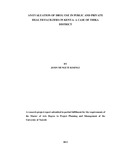| dc.description.abstract | The drug supply system to health institutions especially the Public Health Institutions
in Kenya has for a long time been characterized by many pitfalls. Rational use of
medicines requires that a patient receives appropriate medications to their clinical
needs, in doses that meet their own individual requirements, for an adequate period of
time, and at the lowest cost to them. A previous study on drug use in Public Health
facilities in Kenya was conducted by Health Action International Africa in
collaboration with the World Health Organization in April 2003. The baseline survey
was conducted in Nairobi, Eastern, Nyanza, Rift Valley and Coast provinces and it
was found out that the availability of essential medicines in Public Health facilities
was 90%. The survey also established that there was a general tendency to over
prescribe antibiotics with 78% of patients receiving antibiotic prescriptions, irrational
dispensing was found at 70% of Public Health Institutions. The survey however was
not conducted in Central Province and did not evaluate private health facilities, an
important component of health care delivery in Kenya. The objectives of the study
were to establish the pharmaceutical prescribing practices, patient care factors and
health facility factors that affect drug use in Health Facilities and how these factors
compare between Public and Private Health Facilities. The study was conducted as a
cross sectional survey consisting of 1260 respondents within 42 Health Facilities in
Thika District. The sample consisted of 25 Public Health Facilities with 750
respondents and 17 Private Healthcare Facilities with 510 respondents. The data was
collected on the three key indicators of rational drug use as provided by the World
Health Organization namely prescribing factors, patient care factors and health
facility factors. The data collected was analyzed using Statistical Package for Social
Sciences. The results on prescribing indicators showed that Private Health Facilities
prescribe on average 3.10 drugs compared to Public Facilities which prescribe an
average of 2.83. The Public Facilities had on average 77.16% of all prescriptions with
an antibiotic prescribed compared to Private Facilities which had an average of
62.44% of antibiotics prescribed. The results showed that antibiotic use in Kenya is
higher than in other countries which is a source of concern due to the associated risk
of higher antibiotic resistance when antibiotics are over prescribed. The results on
patient care factors indicated that the average consultation time in Public Health
Facilities 8.10 minutes while the average consultation time in Private Health Facilities
was 8.4 minutes. The results on patient care factors indicate that both the consultation
time and dispensing time in Kenya is longer than in other countries signifying more
personalized attention to patients by the Kenyan clinicians. The average dispensing
time in Public Health Facilities was 118.32 seconds while the average dispensing time
in Private Health Facilities was 225.82 seconds. The results on Health Facility factors
showed that the average cost per prescription was ksh 228.26 in Public Health
Facilities while in Private Health Facilities it was ksh 476.32 indicating that Public
Health Facilities prescribed cheaper drugs. It was concluded from the study that in
order to improve drug use in the health sector, a countrywide study should be
conducted in order to establish drug use information where data is unavailable. The
results from the study are important to the Ministry of Health in drug use strategy
formulation, the county of Kiambu in developing the Kiambu County Health Plan,
medical insurance companies in computing insurance premiums based on the average
cost of a prescription of drugs and other stakeholders in the Healthcare Sector. | |

